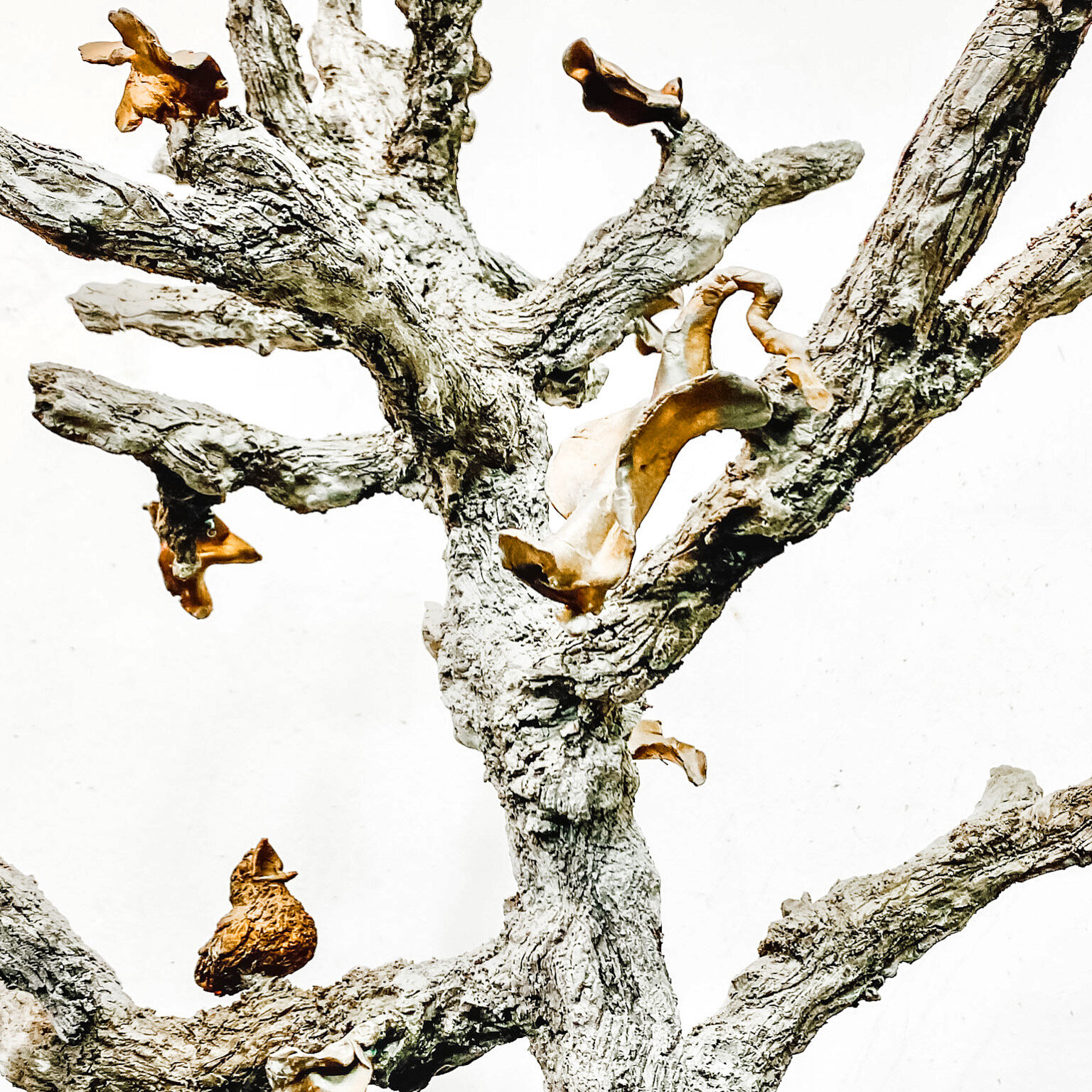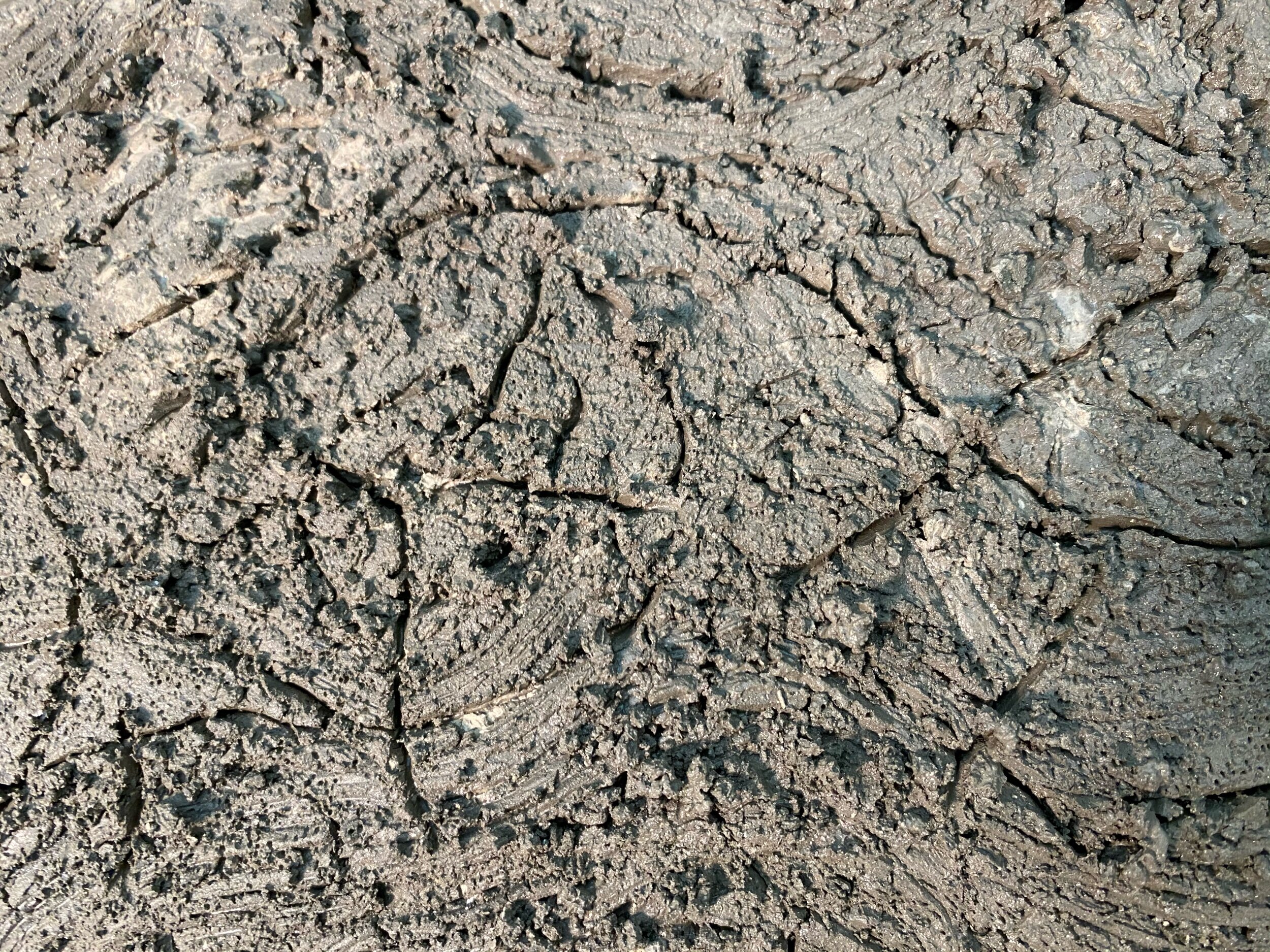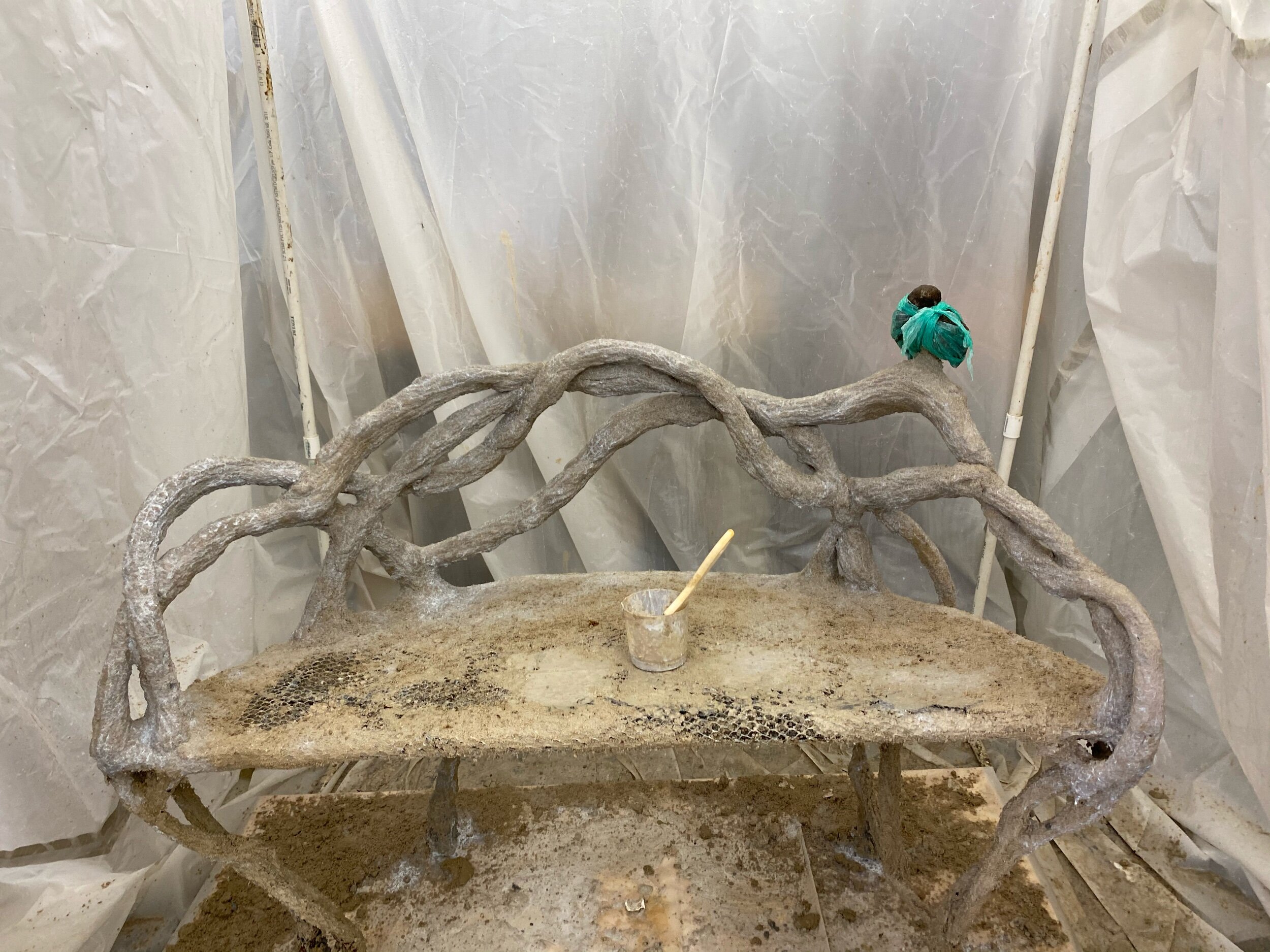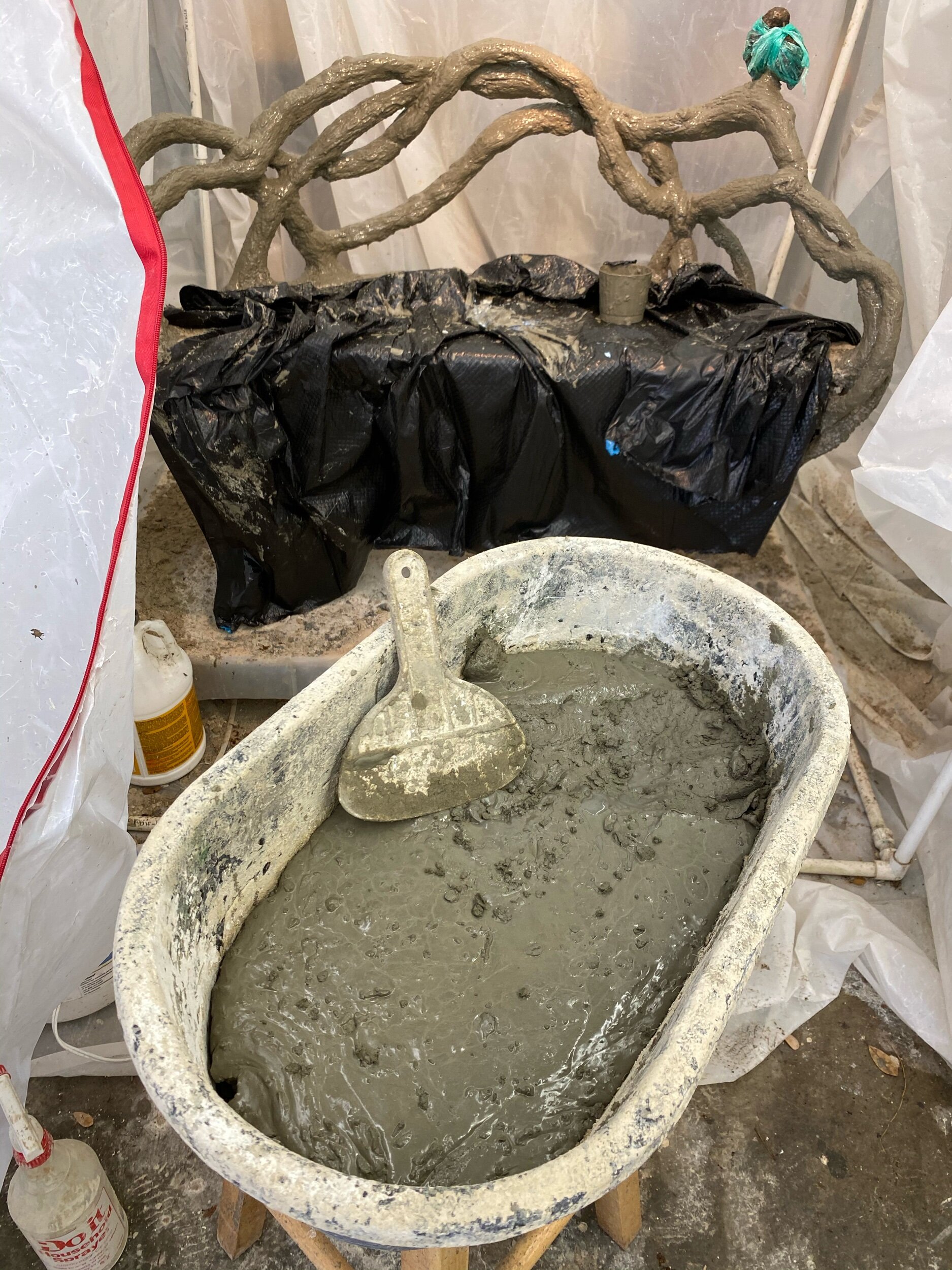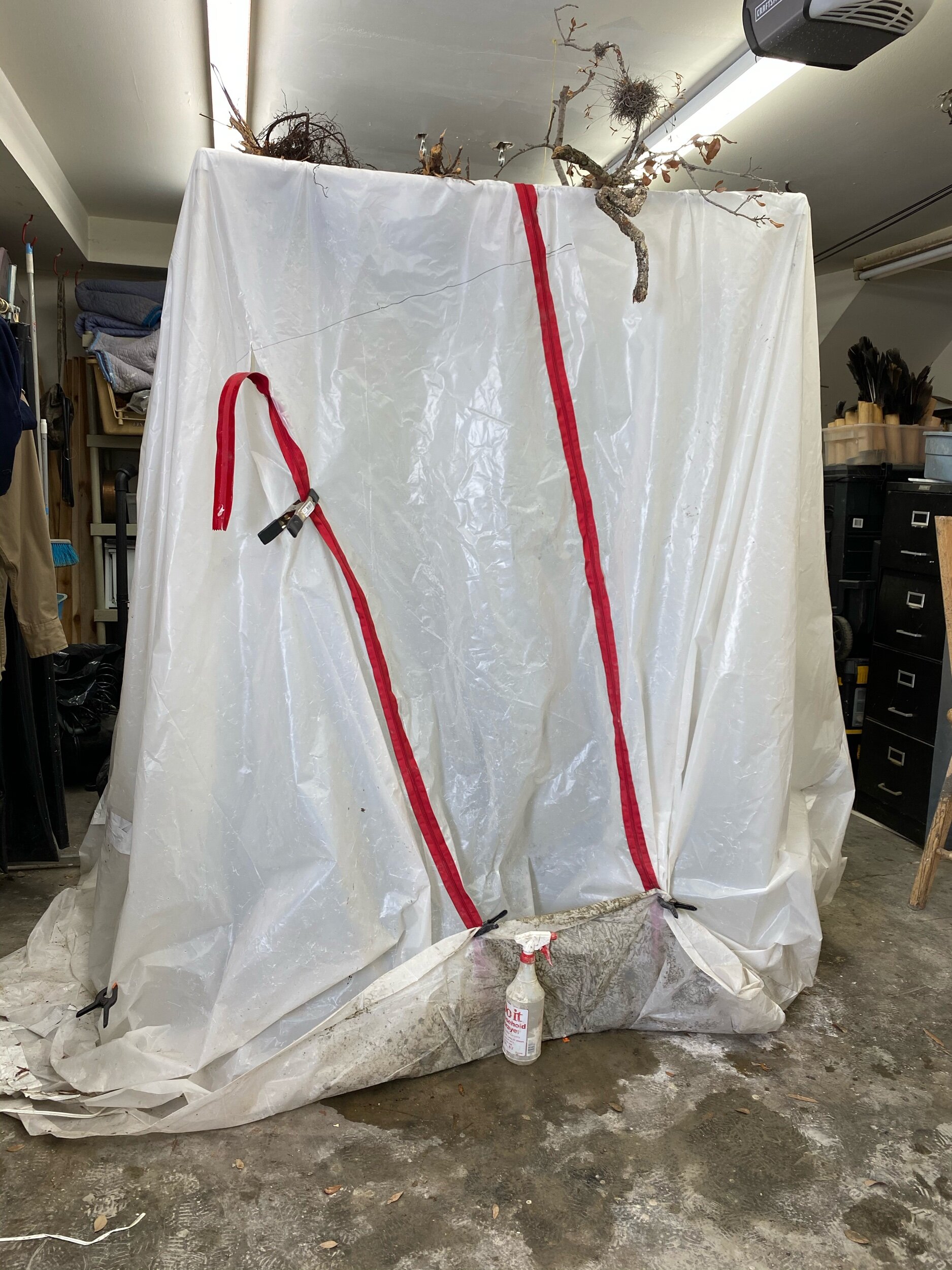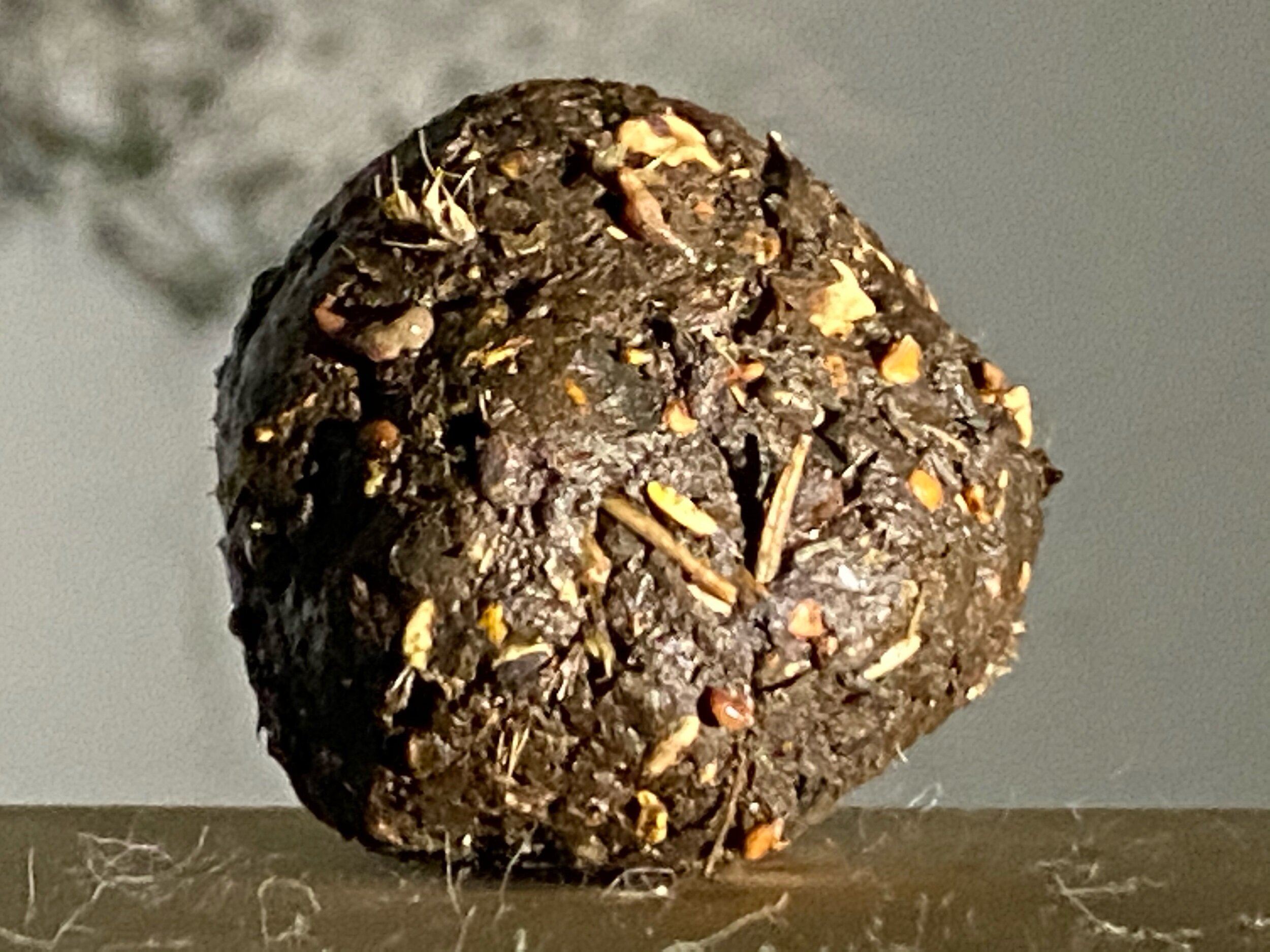It needs a light sanding, a patina on the bronze and the concrete.
Sapling #7 - lath, 1st coat and second coat. (Copy)
My daughter special requested this piece. She asked if I could make her a sapling. My response was I could try, but the pencil size steel limits how thin I can make the tree limbs. Long story short, the sapling grew old fast. After the first coat the sapling limbs we're no longer sapling thin.
Covered in lath
Keeping an eye on my mix
The first coat - the bronze leaves are covered in green plastic to protect them.
First, I paint on the bonding liquid.
The piece is now ready for coat number 2.
Coat number 2 ✅
Here is the image edited super light in order to show the texture.
More details
Detail of upper branches
A little more concrete need under the bird.
Detail of trunk
The lower trunk and base.
The abundance of knots is evidence that this tree is the host of many insects and good bacteria. Bees and other insects use trees for nesting and receive antiviral properties from the fungus and bacteria that grow on the tree.
Art Activist and City council woman #2
This was awesome to receive, I am feeling hopeful. It is amazing to have a city Council Woman who cares and listens to citizens opinions. Screenshot from my phone email.
Sally and Hannah
The video of the FY21 budget workshop-Parks and Recreation was very informative.
Here is what I got out of the video that will help you move the city in an environmentally forward direction. I have broken it down into five steps.
Steve Wright knows the value of native plants and grasses. He expressed that he would like to move more in that direction. He does not because the public is not educated. With Steve on board, this is a great opportunity, and the timing is perfect. Sally, it is great you identified this opportunity, by leading Steve you can save the city money and the planet.
Step One – In Steve's presentation, #5 Greenspace Management (GSM), the city is spending $2,000,000 on mowing esplanades, and in #15 Quality Assurance, they spend $2,500,000 for safety training to maintain the esplanades. Making all esplanades native grasses is a change that will free up a significant amount of money and help all insects as well as the bee. With Covid 19 sucking the life out of the country, the financial savings alone is reason enough to make the transition. This change will start the education of the citizens. Now is the time to take the first step in making Houston a leading city in environmental policy and help with the budget.
Step Two – Steve did not mention the chemical additives or equipment the city uses. City Parks and Recreation would also save money on the chemicals used on manicured landscapes such as herbicides, pesticides, fungicides, and neonicotinoids. This change would also impact the dollars spent on equipment and fuel for lawnmowers. Have Steve add that number up for you.
Step Three- Have Steve's people look at every area they manage: the city libraries, trails, parks, sports fields, golf courses. The zoo should also be charged with evaluating its grounds. Have them identify pockets in these city public spaces where they can save money by transitioning to native plants. There is a lot of precedent in other cities for native plant golf courses. Golf courses use an extreme amount of labor and chemicals; this could be a significant number in the budget.
Step Four – Steve mentioned Public Works land. It was not clear whose budget it is in, but it should be maintained in an environmentally forward thinking manner.
Step Five – Steve was concerned about the public's knowledge of the benefits of native landscaping versus the mindless conformity of the manicured landscapes that we are used to seeing. This education is a project for his new social media employee. In addition, the Mayor should call a press conference and make a big deal of the City Councils' commitment to not only the health of it’s citizens but also the environment and not mindlessly conforming to unhealthy chemically dependent landscape practices and to saving Houstonians a lot of money. The Mayor can also go into the benefits of restoring native prairie vegetation as it decreases water runoff and flooding, increases soil absorption of water and slows floodwaters on land.
A press conference is excellent advertising. It can also be addressed on the citiy’s website.
If you need inspiration, look at the 5/2020 National Geographic, Where Have All the Insects Gone? Pp. 40-65. The article is a study from 1989 to 2016 of flying insects. The study reported a 70% decline. You will find quotes such as "ecological Armageddon", "we find ourselves in the middle of a nightmare", "According to the website Altmetric, which tracks how often publish research is mentioned online, the study was the sixth most discussed scientific paper in 2017."
Insects do the dirty work for us; they pollinate, disperse seeds, are food for freshwater fish, and about every land animal, from reptiles to birds. They decompose our waste; without insects dead, organic matter will pile up. N. G reported the work insects do is equivalent to $57 billion a year in the US.
After you tackle the City Parks, we can look at residential and commerci
Endangered Knowledge: The Soul of Humus #1a and Sculpture Month Houston
In a moment of global uncertainty, I ask myself, what materials would I use to leave a message for future civilizations? As I think of artists who painted caves, of muralists from the past, of artifacts from ancient civilizations, I am curious about how we leave a mark. My answer is tied to the natural world: much of my previous work has been about conservation issues, looking specifically at bees, at waterways, at recovery from Hurricane Harvey, at bison and now, at grass. And so, if I were to write a message to the future, I would use grass to write it, and bison to carry the message.
Endangered Knowledge: The Soul of Humus
For this year's Sculpture Month, I propose a site-specific sculpture of a bison, made from a welded steel armature, a work of land art covered in topsoil and dried native grasses. This is part of a comprehensive installation that I am currently developing, which considers the role of the American bison within Houston's specific soil ecological history. The work is titled Endangered Knowledge: The Soul of Humus.
It is inspired by the words of M. Thomashow, who writes, "Record natural history to the collective memory so that it is no longer endangered knowledge." For several years, I have been researching grass-fed food production, attending soil conferences, and visiting regenerative ranches. Research in these fields show how to fight desertification and reverse climate change through regenerative agriculture practices. Interestingly, this natural history of living soil, how it evolved in the Houston Coastal Prairie, and its essential part within microbial communities in human health, is not common knowledge.
Description of Work
In the hide of a sculpture, I tell the narrative of soil health. My sculpture will record this endangered natural history through the dense coat of the powerful humus-built bison, that will be dripping in the armor of locally sourced dried native grasses and sedges, seeds, and pods. The male bison will be supported by a welded steel armature, covered in a stainless-steel lath. The bison's skin, made from these dried grasses, will be attached to the lath with a Houston mud composite. I propose the 11' long bison be exhibited in the center of a large grain silo, the bison in an actively grazing stance, head down in plow position, his hump rising robust and bushy out of his heavy forequarters to 6.5' tall. Lighted from inside the grain silo funnel, viewers can approach the bison and intimately inspect the diversity of the native plants implanted in its pelt.
Ecological History
Historically B. bison functioned as the first farm equipment. The grass seeds clinging to their burly coats were carried across the plains as they migrated north to south and back between seasons, like tractors up and down fields. Herds of tractors not green, but a rich brown harvested the plains with their appetites, each bite stimulating new root growth. The old roots withered into cavities that served as dwellings for a variety of keystone species, and became underground cisterns collecting floodwaters for drier seasons. Their coats dropped kernels and cuttings as the winds ruffled their beards and chaps, and when they took dirt baths in buffalo wallows dug with their horns. Massive roaming compostors, a single bison cow daily dumping 40 lbs. of fresh manure onto these seeds and drilling them into the earth with their spade-like hooves, sprinkling them with the perfect prescription of nitrogen, phosphorus, and potassium-rich urine and then moving in a predator safe tight herd on to the next buffet. With time the newly sowed fields sprouted new growth of blades, stems, and leaves of countless shapes, sizes, and heights. This diversity of leaves fit like puzzle pieces into dense living solar blankets, harnessing carbon from the air and returning it as sugars to feed the dynamic root microbiomes below the earth’s skin. The complicated relationship between the soil microbiome and the human intestinal microbiome is one of the most dynamic topics in biomedical research. Flocks of birds mutualistically
living off the pests harbored on the bison followed the herds, drinking from and bathing in rainwaters that collected in the bison wallows, building their nests from clumps of bison fur. Recent studies show the fur provides a health benefit to unborn chicks. Bird and butterfly habitats were abundant when the bison roamed.
Relevance
Global warming, food security, drought/flooding, wildlife habitats, economic instability, and health – these problems are not new to humankind. The archeology of ancient civilizations has recorded connections between the longevity of civilizations and the health of their soil. The United Nations reported in 2014 that the world's topsoil would only last 60 more growing seasons. Soil scientists around the globe agree that solutions to these issues are rooted in our treatment of soil—the skin that covers our planet.
Message to the Future
The armor that protects the epidermis in the Gulf Coast prairie is grass. The animal whose population peaked at 30 million, is B. Bison. Combine native grasses with ruminants and the grasslands decompose into rich organic matter; for every 1% increase per acre of biological organic material, the soil can hold an additional 20,000 gallons of water. Restoring native prairie vegetation decreases water runoff and flooding, increasing soil absorption of water and slowing floodwaters on land. With extreme building practices and concrete hardscaping, reimagining the landscape of Houston's 600 square miles of real estate can make a significant impact on the region’s flooding. The prairie grasses' roots can extend from eight to fourteen feet deep: these roots sequester carbon like an upside-down rainforest. Changing our agricultural practices is an important step towards turning global warming right side up. Telling the dynamic story about these relationships between the grazing herds, the living soil, and finding ways to reimagine urban landscapes and agricultural practices in holistic and regenerative ways are the center of my current research and sculptural practice.
The impact of the bison on sustaining topsoil—and, therefore, life—need not be Endangered Knowledge. The role bison play within the prairie ecosystem—their ability to increase photosynthesis, reduce competition for water, and regenerate depleted, unsalvageable, lifeless prairies back to productive and bountiful, nutrient-producing land and wildlife habitats—needs to be carved into our modern systems. Recording this Endangered Knowledge into the consciousness of humankind will stimulate grassroots efforts and stop the cultivation of soil depletion and return the natural process to the treatment of the skin of our planet. A Parietal artist in 2020, I will use grass to record the Soul of Humus so that it will no longer be Endangered Knowledge.
Additional work
Soul of Humus will be the first piece in my Endangered Knowledge body of work. The complete body of work will eventually consist of the following sculptures: 4 pedestal-shaped sculptures of roots and soil, measuring approximately 12" X 12" X 36"; installations made from native grasses and their roots (size and number to be determined); 1-5 bronze castings of bison dung with their spade-shaped hoof prints, dung beetles, and mushrooms. I am also currently in conversation with a bison rancher to secure a bison heart to float in a glass case of formaldehyde: the bison, the largest mammal of the western continent, is the heart of our soil diversity, it is the western symbol of a healthy planet. The health and longevity of civilization, as we know it, is dependent on finding ways to mimic the natural process stampeded into the bayous of Houston. In this sculptural series, I look closely at the components of this process and the environmental interrelationships unique to the Houston area and world health.
Footnote-
Bison vs Buffalo which name is correct? The common name Buffalo has been widely used, since early settlers were naming them as their European and Asian counterparts. The correct name of the last American surviving bison is B. Bison.
Further Reading and information –
- Allan Savory on how to fight desertification and reverse climate change
- Soil as Carbon Storehouse: New Weapon in Climate Fight? - Yale E360
- A Prehistory of Houston and Southeast Texas,– D. Worrall, coming fall 2020
- Can Livestock Grazing Stop Desertification?
https://www.scientificamerican.com/article/can-livestock-grazing-stop-desertification/
- Dirt: The Erosion of Civilizations, by David R. Montgomery
- Soil Biology and Land Management https://www.nrcs.usda.gov/Internet/FSE_DOCUMENTS/nrcs142p2_052489.pdf
- Wildlife that Depend on Bison
Sample Work and Visual Support Materials for Proposed Sculpture
Two small sculptures that are made with the same structure, process, and made with native plants-
The bison will be furrier than these small birds are and would be dripping in a thick coat of textured dried grasses.
Hay Day Peace Pigeon 2016
15” X 12” X 8”
welded steel armature, plaster and hay
Feathery Finery Peace Pigeon 2016
12” X 12” X 6”
steel armature, steel lath, plaster and plants
Three large sculptures that are made with the same armature and process, but I have used metal instead of dried plant cuttings on the surface for texture.
Broken 2018
40” X 29” X 55”
Welded steel armature, stainless steel lath, concrete, wire cloths and wire
Sonata in 4D 2018
6’6” X 5’5” X 5’
steel welded armature, stainless steel lath, plaster, wire cloths and wire
Bringing Home the Bacon 2019
66” X 42” 60”
welded steel armature, stainless steel lath, hydro stoner, wire cloths and wire
There are many textures of native grasses at the Katy Prairie Conservancy and Buffalo Bayou.
If you accept my proposal, I plan on asking the Katy Prairie Conservancy and the Buffalo Bayou Partnership to allow me to source my grasses and plants from their properties.
Sample of one of the many amazing textures on the various grasses and plants in the coastal prairies.
This shows the movement I am visualizing on the coat of the Bison
Below are Some of the source images I will use while sculpting the bison.
most of these I took doing research at Roam Ranch this summer, fall and winter.
This shows the position of the head I am looking for, it is grazing but you can see the face. This is a cow (female) My piece will be a burly big old male.
This is a large bull but it is not very old. My sculpture will be an old male that will have scrapped up and chipped horns from fighting and digging wallows and a massive thick (and dripping with dried grasses) big beard and chaps. This side view is pretty close to what I have in my head. I might have his head turned slightly to one side. That could be determined by which side of the building the silo would be on. The face will be more interesting and textured than the back side of the bison will be. My sculpture would be grazing on taller grasses. I would also raise his head for more eye contact
This is a good image of a bull’s face. Not my photo.
another view- not my image
Art Activist and City Council Woman
It was never my intent to become an environmental activist – I am beginning to wonder if that is what I am. Since the below email I have had one meeting with Sally Alcorn and her assistant Hannah Cobb. They are on board with my thoughts and want to help. We decided the first step is to look at the citi’s present landscape ordinance, and then Coronavirus 19 hit Houston.
I guess even in a pandemic certain things have to continue, such as city budget planning. I received an Instagram message from Sally April 27th at about 11:00 pm regarding a video of the City Council meeting and the City Parks budget. I will make another blog post summing up the results of that meeting. Maybe this pandemic will open some doors that normally would not budge.
TO: Sally Alcorn salliealcorn@comcast.net
Dec 27, 2019, 10:14 AM
RE: Houston’s impact on bees.
Sally,
It was great to run into you at the mother-daughter Christmas party. I appreciate your interest in positioning Houston to become the leading city in the U.S., addressing the native bee environmental issue. You have a lot on your plate with your new elected position, so I thought I would recap a few of the important topics we discussed.
Scientists predict that without pollinators, human life can only continue for four years. In 2017, the U.S. Fish and Wildlife Service listed the Rusty Patch Bumble Bee on the endangered species list. The campaign to list a species as endangered is lengthy and complicated. With this system, it is difficult to gauge how many species are actually endangered.
Bees are responsible for pollinating 75% of the world's flowering plants; they are crucial for the production of most fruits, nuts, and berries – our agriculture depends on pollination by bees.
Rural areas are highly impacted by the unanticipated consequences of our industrial agriculture’s dependence on chemicals that weaken bee’s immune systems. Urban bee populations can be more diverse than in rural areas. Researchers are finding in cities such as Chicago, Berlin, Berkley, and Melbourne that have reimagined their parks, neighborhoods, city centers, vacant lots, street medians, and rooftops planted with native flowers, grasses, and fruit, and vegetables support healthy, vibrant wild native bee populations.
In the US, there are four thousand native bee species. They pollinate over three hundred times more effectively than honey bees. For example, A single female Leafcutter Bee visits 100,000 plus blossoms per day whereas a honey bee visits 50-1000.
Unlike the honey bee, Native bees do not swarm, are not aggressive. Native bees are perfect for urban population centers.
Houston covers 600 square miles of land and has one of the longest growing seasons in the U.S. As it continues to sprawl across Texas, its gardens must increasingly become a refuge for native plants and animals. With 2.3 million people living in the most vital economic, cultural center of the south, we can become the most critical urban native bee habitat in the United States.
I have spent the last year and a half studying the bee situation as it pertains to my art and my interest in regenerative agriculture. I am determined to take this knowledge and save the bee in urban settings.
With Houston's land size, population, and location in the Sunbelt like it or not-we are impacting the bee population.
I realize we will have to start with baby steps. Let's put our creative minds together, save the native bees, and build a better energy capital. This is a great opportunity for our new city council.
I am very flexible are weekdays or weekends better for you to get together?
Best,
Cindee
P.S.
If Cuba can create urban gardens to feed it’s poor can you imagine what we can do.
Faux bois Wedding gift ❤️❤️#15
Today I poured 30 lbs. of white concrete and 29.5 lbs. of grey Portland for the seat. In the mix was .5 lbs. of the ashes of Robert Ira Travis, my dad. He was born on December 10, 1927 he passed away March 24, 2018. When I measured out the ashes thIs small metal piece was in his ashes. I think it must have been part of one of his four hip replacements or two knee replacements. It was like finding the toy in a box of cracker jacks. I think Griffin and Alex will enjoy it embedded in their piece.
Bolt, name and ashes of R.I. Travis.
I used the white concrete to create motion in the old wood.
I went a little crazy
The seat has lots of rings from burls in the plank. Griffin and Alex love bugs and mushrooms (the fruit of fungi) both of which cause burls. The seat of their bench is riddled with big burls.
A sweet knot with some severe old wood cracks.
Once the piece hydrates for 5 days I will take a sander and smooth down the seat.
I gave the birds a knot to perch on.
Another view of Bob Pa’s moment in the bench.
Every few hours I check on the marks to make sure they have not filled in. There is a lot of concrete on the seat and the white concrete is taking a long time to set.
Faux bois Wedding gift ❤️❤️#14
I was not happy with the results of last Thursday's work on the upper branches. The concrete was not sticking to the scratch coat. Afterwards I went through the past blog posts for this piece and this is not the first time I have had trouble with the cement sticking. I made note that the liquid part of the concrete mix was too old. Good to know, the best part of a blog is the documentation of the work. As a result of the old liquid the branches ended up lacking detail. That is what happens when one takes multiple year's to finish one project. Today's work looks better. It does have it's share of wormholes and I love wormholes. I am a sucker for any piece of old wood eaten up by worms. That is the beauty of old wood.
Wormholes and knots
Below is a photo journal of the process.
Mixing the wet part of the concrete mix.
Mixing concrete is very similar to baking, you have to measure every ingredient precisely and mix them in the correct order.
A sound concrete mixer is a must; hand-mixing concrete is just too physical. I love this machine. Behind the mixer you can see roots for future bronze pieces drying on the plant trellis
Fifteen minutes of mixing the dry ingredients.
While I wait for the dry ingredients to mix I paint a bonding agent onto the scratch coat.
A close up of the white bonding agent after application.
All branches are coated with the bonding agent and drying while I check on the cement mixer.
When you look closely you can see the fibers I put in the concrete last week. The fiberglass fibers help the new layers of concrete bind to the last coat.
Just like in baking, you pour just a little wet ingredients in the middle of the dry ingredients.
I clip a cardboard door to the mixer, to keep the dust down.
The mixer kicks up a lot of dust.
Even before ppe was a thing, I wore a respirator and a head covering when mixing cincrete. There is nothing like shampooing concrete dust out of your hair.
Here the mix is starting to stick together and make marble and golf size balls. Ut us about 1/2 way ready.
Ready to start applying the concrete to the branches.
First, I mix a little concrete with the white bonding agent and make a slurry. I paint the slurry mud into the branches to help the first coat stick. Then I wait for it to get tacky.
Another detail look. Some of the fibers from the prior coat are still sticking out. That is ok, when I am finished I will take a small torch Abd burn them off.
My hydrating tent is getting a bit caddy campus.
Five more days of hydrating and then I pour the cement for the seat.
Gorilla Art - native Wild flower bomb
Earlier in the year I sent the below letter to my City council representative. She is very supportive and agreed to review the Cities landscape ordinance and bring it up to date to reflect our current environmental situation as it pertains to native bees. The bees that are endangered, the honey bee is not endangered. I anticipate that with the health scare our city is facing our bees have been put on the back burner. Since the bees can’t wait for the c virus to die down, I decided I need to act. . Below is my letter. If you agree with me we need to all become gorilla artist and install texas wildflower seeds in every vacant spot we can. See my below post for how to be a gorilla artist and save the Native bees. If you want something done do it yourself. I still have hopes our city will reimagine our urban landscape and save the bees. #bees #houston #cindeeklementart #gorillaart Scientists predict that without pollinators, human life can only continue for four years. In 2017, the U.S. Fish and Wildlife Service listed the Rusty Patch Bumble Bee on the endangered species list. The campaign to list a species as endangered is lengthy and complicated. With this system it is difficult to gauge how many species are actually endangered. Bees are responsible for pollinating 75% of the world's flowering plants; they are crucial for the production of most fruits, nuts, and berries – that our agriculture depends on pollination by bees. Rural areas are highly impacted by the unanticipated consequences of our industrial agriculture’s dependence on chemicals that weaken bee’s immune systems. Urban bee populations can be more diverse than in rural areas. Researchers are finding in cities such as Chicago, Berlin, Berkley, and Melbourne that have reimagined their parks, neighborhoods, city centers, vacant lots, street medians, and rooftops planted with native flowers, grasses, and fruit, and vegetables support healthy, vibrant wild native bee populations. There are four thousand native bee species. They pollinate over three hundred times more effectively than honey bees. For example, A single female Leafcutter Bee visits 100,000 plus blossoms per day whereas a honey
Mix native wild flower or grasses seeds with soil. I am using a handful of compost from my bin.
Wrap it up so you can carry it and not get your hand muddy.
Find a place to throw it that will not be mowed. I picked behind this chain link fence, in the parking lot of my art studio.
Here she lays.
A closer look at - native wild flower seed bomb.
Three weeks later.
There are so many weeds sprouting up it is hard to see my seed bomb. But I see it. It does not have any blooms yet but my fingers are closed it will.
Since we are in quarantine I decided at this time to not make a bunch of bombs to share with others. I would love to share but I am erroring in the side of caution. i put the rest of my wild flower seeds in my flower beds that I needed more plants.
Falling through the bee looking glass #1
In the past years, blogging about my art practice was something I did every day. It is how I document my work. Then I started focusing on bees. At first, it was bees and the weed killer Glyphosphate.
The above pieces we're done in response to learning that Glyphosphate does not kill bees but impacts their immune system. With compromised immune systems bees subcome to disease. Glyphosphate is also now well known for causing cancer. I then made a five flip lenticular from these three images.
Copy of SITE Gallery- Sculpture Month Houston - Installing the work#2
Things are now going smoothly maybe too smoothly. All the work I did this summer is paying off.
SITE Gallery- Sculpture Month Houston - Building the support system
Finally, I feel like I can make some progress. Step one is to make a structure that I can hang my sculptures from. The gallery owners are trying to preserve the space in its original condition, and ask the artists to deface the silo as little as possible when installing our work. Normally I use acrylic hangers that I designed to hold the pieces. Each bracket takes four anchors. I feel like that is too much destruction to the silo. Instead, I decide to buy some black 14 gauge wire fencing, 20 feet X 36”. The silo funnel has metal bands tack welded to it. The middle metal band is 31” from the wall. I cut the fencing in 31” pieces. I cut one end in a concave shape and the other end convex. The convex end will rest on top of the metal band and the concave end will be supported by two screws in the cinderblock wall. This is 19‘ high, and I feel pretty good that my screw holes will only be minimally defacing the silo.
Close up of support system
The moment I got off the scissor lift and looked up at my support system, I realized I had made a big mistake. I should have painted them white. The black stood out too much on the white walls. I could not sleep that night trying to decide if I should repaint them... It was not easy, but I spent the next half day painting the system 19’ in the air white.
I think it was worth it, the support system is much less intrusive.
I hung from the support system 8 fishing tackle swivels with 25 lb filament attached to each swivel. Four of the swivels are 36” apart 18” from the wall. At these distances the pieces will not touch each other or the wall. Everything should move independently. These are for the big pieces. The other swivels are for smaller pieces and are spaced randomly. I am guesstimating where I want these. Tomorrow I will start hanging work.
My new best friend’s name is Scissor Lift- Another day setting up my silo to work.
I am so grateful to not have to deal with that 19’ tall scaffold. It was very difficult to maneuver in the space with the mouth of the funnel hanging in the center of the space. Aztec picked up the awkward scaffold today, and they delivered my new best friend, scissor lift. Getting the scissor lift in my silo was not a simple processes. Electrical conduit hangs below the door frames of the silos between my silo and the delivery door. As a result the delivery man had to drive the scissor lift through 8 other silos to get to mine. It fit in the door of my silo exactly with not a pinch to spare. The scissor lift rubbed the top of the opening.
My safety engineer and the most supportive husband anyone could ask for. He is affectionately known as Mr.Safety. 🤗
The view of my silo workspace from the scissor lift.
Detail of grid system.
Butterflies and family
One of the joys of parenthood is enjoying nature through your kids at any age. Last night, Griffin sent us this image of a monarch caterpillar that he found in Minnesota this weekend. A few years back on Thanksgiving, we went to see the monarchs. It is a site to behold and a lovely outing. They really liked Sage. Respectfully enjoying the beauty of nature has long been a great joy for our family.
Sage provides fb a resting Place for a monarch
Griffin sharing a caterpillar with us from Minneapolis.
The honey bee is (as American as apple pie) not a native bee in the US.
Like apples, honey bees were introduced to North America in the 17th Century by the European settlers. Prior to the arrival of the European settler’s honey bee, native insects and bees handled the task of pollination in the new world. In the early 1600´s, the honey bee was brought to North America for honey production and beekeeping became a commercial and profitable occupation.
My next post will be honey bees vs native bees. #savethenativebees
Tomato cage sculpture material
I ran to Southland hardware to purchase more wire cloth for my installation and spied some tomato cages. Wondering if they could add to my palette of materials I took home a few to play with.
Tomato cages
Squish, squash, twist, turn, fold, pull, cut repeat
Throw on a rip of charged screen for garnish
Play some more.
I ran out of time today but I feel like it might have some potential.
The Bees Needs
“Modern farm economics have created an enormously productive system of genetically engineered, chemically dependent agriculture. But it relies on just one domesticated insect to deliver a third of the food on our plate.
And that insect is dying, a victim of the very food system that has come to depend on it.” - Josephine Marcotty, Star Tribune
http://static.startribune.com/news/legacy-apps/bees/
What the bees needs- Where you spend your grocery dollars matters, supporting local, organic farmers is supporting bees.
Glyphosate
44” X 30” water color monotype
The image above is the first piece I created in this body of work. I hope to start a buzz with urbanites regarding the ramifications of food purchasing habits, yard weed control and pest control in regards to the bee.
You can help the bees by letting our government know how you feel about our current situation. See the link below.
https://www.regulations.gov/comment?D=EPA-HQ-OPP-2009-0361-2340
Sewing 🐝 road trip to Roam Ranch
I stitched endangered species on our road trip to Roam Ranch near Fredericksburg. My supportive husband Curtis did the driving so I could stitch.
I free stitched it and you can tell. Why make it by hand if you want it perfect, right?. It does look better than my regular handwriting but that isn’t saying much.
The trip was an incredible experience; worthy of a well thought out post just on the Ranch and the stewards of the land and animals - Taylor, Katy, Cody and Julia.
One for the home team-conservationist win, we thought.
“12 neociotinoid pesticides are pulled from the market”- Muenster Enterprise
I can home Wednesday night a few weeks ago and found a newspaper clipping sitting at my place on our kitchen island. The clipping is from the Muenster Enterprise, a weekly newspaper from my husband’s hometown Muenster, Texas. Curtis reads it every week to keep up with his many cousins. He saved me the article because it reports great news for bee lovers.
Besides 12 neonicotinoids being pulled off the shelves the EPA is now required to analyze the impact of the entire class of neonicotinoids on endangered species.
This morning in my notices I read very disappointing news about the EPA.Even after loosing lawsuits the EPA finds ways to authorize use of chemicals that harm bees. See the below link.
Glysophate
Artspace111 6th Annual Regional Juried Exhibition
Artspace 111 report the the artist that Hilde selected 59 artist out of 1300. Man! I feel lucky to be included.

